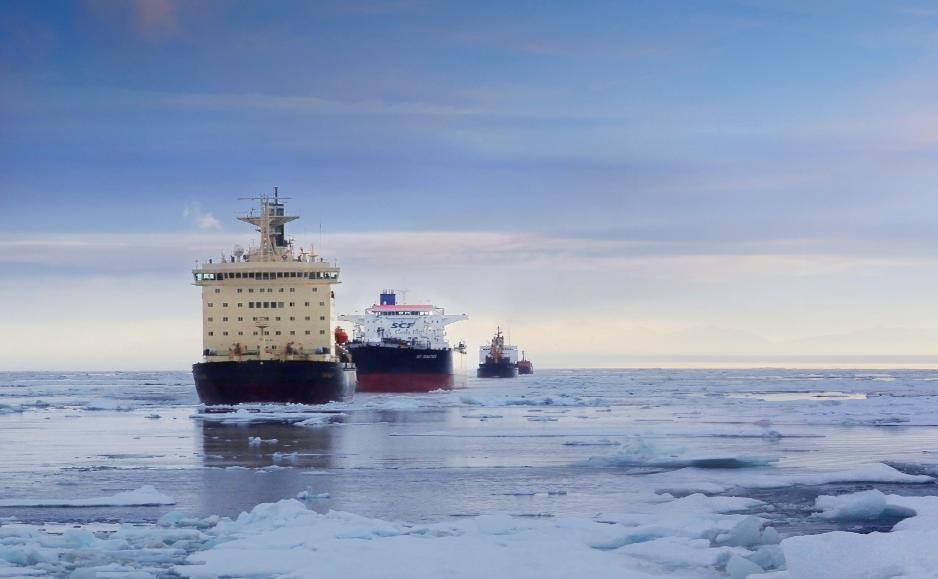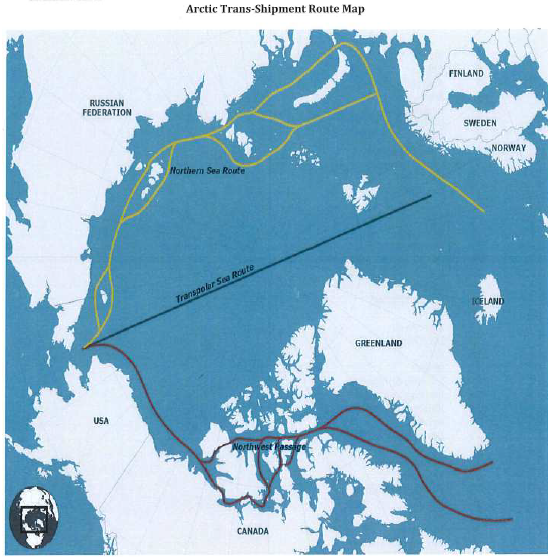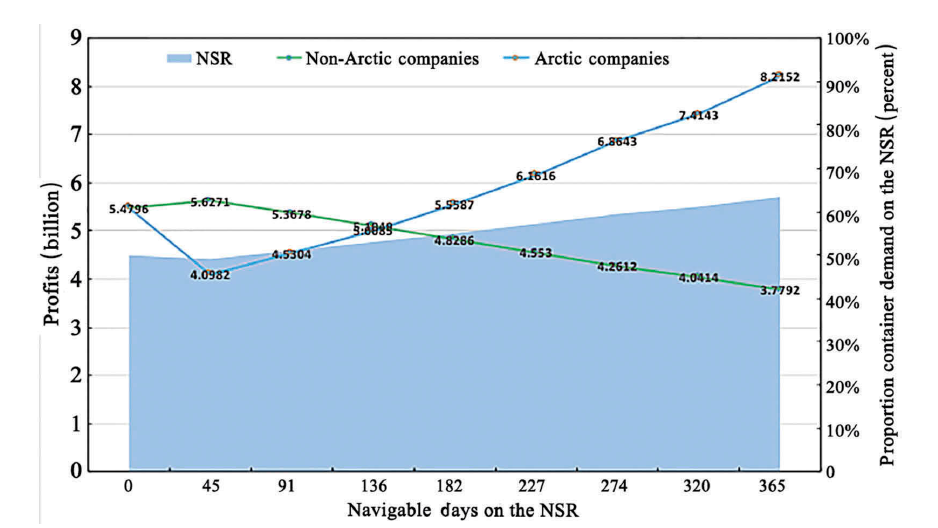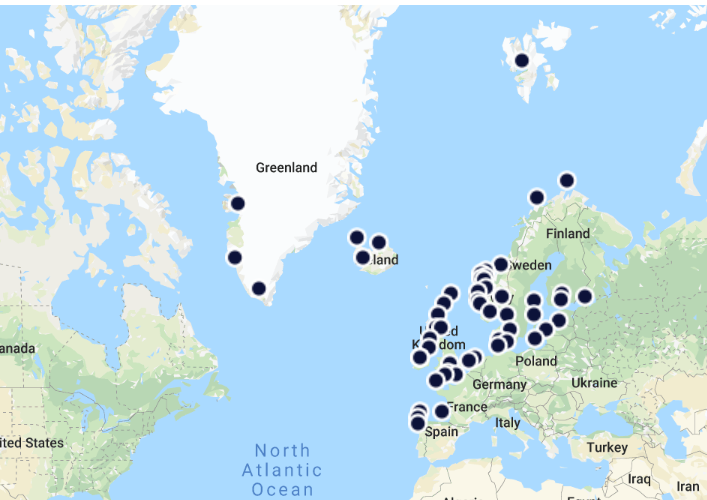In the name of the Arctic

A convoy of ships sailing along the Northern Sea Route. (Photo: Rosatomflot)
What are the motives of the Arctic Shipping Corporate Pledge signees?
This op-ed is written by Alexandra Middleton, Researcher at Nord University, Bodø/Norway.
On 23, October Nike signed the Arctic Shipping Corporate Pledge initiated by the Ocean Conservancy. The pledge invites businesses and industry to join in a commitment against shipping through the Arctic Ocean.
Ocean Conservancy is a not-for-profit advocacy organization founded in 1972 based in Washington D.C., United States. It has been active in advocating protection of marine mammal, fisheries, coral reefs, etc. The Arctic Shipping Corporate Pledge is the recent initiative coordinated by Ocean Conservancy. The pledge is a half-page document with a map of possible Arctic routes (see Map 1).

Map 1: Arctic Trans-Shipment Route Map. (Illustration: The Arctic Shipping Corporate Pledge)
Companies signing the pledge commit to avoiding Arctic trans-shipment routes and promoting precautionary Arctic shipping practices.
Who signed the pledge?
So far, the signees of the pledge include two groups of companies; fashion related companies (Nike, Bestseller, Columbia, Gap Inc., H&M Group, PVH corp, Li &Fung and Kering); and oean carriers (CMA CGM, Evergreen, Hapag-Lloyd and Mediterranean Shipping Company).
Virtue signalling
Why are these fashion companies interested in the Arctic? With massive dependence on Asia as the manufacturing base and with goods being shipped all over the world in containers, these companies have a significant impact on global warming. The most profound effect comes from Black Carbon “a tiny black particle found in smoke, including ship exhaust”. Black Carbon from all sources is the second largest cause of human-induced climate change and is a contributor to the rapid decline in Arctic sea ice. Black carbon accounts for 21% of CO2- equivalent emissions from ships.
Currently, no transhipment of containers is done via Arctic routes and the estimates on when it will become viable vary. The largest container ship operator, Maersk had “one-off trial voyages” along Northern Sea Route (i.e. over the Russian Arctic) and did not find it cost-effective. One of the incumbent sea routes is via the Suez Canal. The Suez Canal’s expansion in 2015 resulted in an increase of cargo shipped, but also contributed to documented threats to ecosystem and human activity, with e.g. introduction of alien species to the Mediterranean Sea.
Saying “no” not Arctic shipping is an easy way for fashion companies to show off their moral superiority without any responsible investments required. Notable, they do not pledge to change their business models or their current shipping arrangements than in first place contribute to global warming. Pre-emptive claims on the Arctic future are just enough to get good publicity.
Fast fashion
Many signees represent “fast fashion” companies introducing new fashion collections every year, quick turnarounds and often lower prices. Such business models encourage over-consumption and generate excessive waste. Apart from environmental concerns, fashion companies have been in the spotlight since the 2013 Rana Plaza garment factory tragedy killed at least 1,132 people.
Out of pledge signees, Nike has largely withdrawn from China because of the rising cost of labour. H&M provides a table with minimum floor factory worker wages and actual wages paid in 2018. For example, in Bangladesh H&M pays 100 US dollars per month as compared the current minimum wage of 67 US dollars. However, 100 US dollars is a pittance when compared to a minimum living wage estimate which was 191 US dollars in 2018.
Saying “no” not Arctic shipping is an easy way for fashion companies to show off their moral superiority without any tangible responsible investments required. Notable, they do not pledge to change their business models or their current shipping arrangements that in first place contribute to global warming.
Financial interests
The second group of companies are the world’s largest ocean carriers, which represent an increasingly concentrated sector. Collectively the signees of Arctic Shipping Corporate Pledge - CMA CGM, Evergreen, Hapag-Lloyd, Mediterranean Shipping Company - control 41% of the container shipping market. Concerns have been raised that the pledge signees involve in “greenwashing”, trying to appear more environmentally friendly than they really are.
These firms are interested in profit maximisation for their shareholders. In 2018, CMA CGM recorded revenues of $23.5 billion, up 11.2 percent, Hapag-Lloyd, $13.6 billion, compared with $11.2 billion in 2017. Container shipping will experience challenges including an increase in operating fuel costs and price volatility due to compliance with IMO 2020 sulphur cap of 0.5 percent entering into force January 2020.
While environmental concerns of the Arctic shipping impact are noble, these shipping moguls do not seem to publicize their financial stakes. Studying the effect of Arctic sea routes on the global maritime container transport, Yangjun et al. (2018) demonstrate that non-Arctic shipping companies, which sail on the current routes all the year round are likely to be in a disadvantaged financial position as compared to Arctic-shipping companies (see Figure 1). In addition, investments into ice-class ships appropriate for Arctic shipping present an additional financial consideration.

Navigable days on the Northern Sea Route (NSR). (Illustration: Yangjun et al. (2018), p. 9)
Arctic cruises do not count, or do they?
The ocean carriers pledge signees choose to remain silent on their Arctic cruise operations. For instance, MSC Cruises is a daughter company of pledge signee MSC. MSC Cruises is the world's largest privately held cruise company. Landing on their website you can easily book trips to a variety of the Arctic destinations in Greenland, Iceland and Svalbard. Similarly, Hapag-Lloyd sells Arctic cruises on its new Hanseatic nature ship for summer 2020.

Map of cruises destinations. (Source: MSC Cruises)
Walk the talk
Arctic is very much in the news and is an easy catchword that can be used to gain publicity. It appears that both types of companies are not entirely open about their motives to support the pledge. Meaningful interventions for protecting the Arctic could include, for instance, commitments in reducing Black Carbon, investing in greener vessels, having sustainable business models based on circular economy principles and mitigating environmental impacts on the container shipping via the Suez Canal.
As it stands now, more studies are needed on long-term environmental and socio-economic risks and benefits of Arctic shipment routes vs. continuing business as usual.
